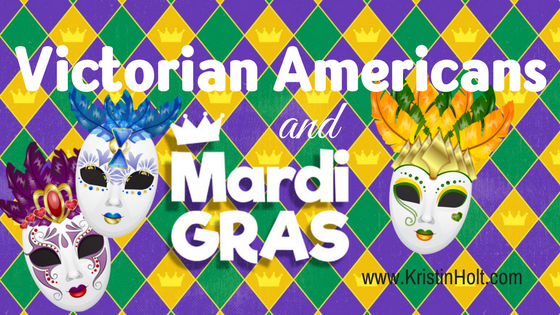
by Kristin Holt | Mar 9, 2017 | Articles
Etiquette governing balls and dances in the American Victorian era seems stuffy, old-fashioned, and strict to 21st century Americans. Every rule of decorum ensured good manners were in play, but most importantly, the moral purity and innocence of young women and young men were maintained. Etiquette governed everything from how a man asked a woman for a dance to how he could properly hold her hand while dancing, to how many dances that pair could have in one evening. This article contains the specifics propriety demanded, and the vintage sources where they may be found. Leap year turned some of the lady’s restrictions upon the men; see the true-to-history newspaper article from 1888 that starred in Sophia’s Leap-Year Courtship.

by Kristin Holt | Feb 28, 2017 | Articles
Victorian Americans loved their celebrations, holidays, and reasons to party. Mardi Gras, in North America, has been around since pre-American Revolutionary War. I share tidbits about the background of Mardi Gras, how it was celebrated during the staid and usually straight-laced Victorian era, and some of the challenges present to law enforcement in the latter half of the nineteenth century. Wow! I can only imagine!

by Kristin Holt | Jan 28, 2017 | Articles
In the third and final article about Nineteenth Century Ice Cutting, I share some of the highlights of the history surrounding a Boston entrepreneur’s ice company, both domestic and foreign. Historic sources share insights and facts that make ice a pretty cool subject to study! See vintage images of ice cutters at work.

by Kristin Holt | Jan 22, 2017 | Articles
Nineteenth Century Ice Cutting, Part 1 (of 3): Ice cutting was a boom business in the mid 1800s. Tons of ice were harvested each winter in the Northeast portion of the United States, housed near rivers and railway spurs, and shipped near and far for use in the remaining seasons of the year. An image from August 1884 Harper’s Weekly, a patent from 1841, a spot of Victorian humor, and newspaper clippings shed light on the significant ice trade.

by Kristin Holt | Oct 20, 2016 | Articles
Nineteenth Century American Bath Houses were often businesses connected to hotels, barber shops, ladies’ hairdressers, and spas offering massages and curative measures (steam baths, medicated baths, etc.). In the Old West, such businesses advertised in the newspapers of the day, some announcing prices (compared to today’s dollar). It’s a peek into the luxury of a wet-from-head-to-toe bath when a person has no running water at home.













